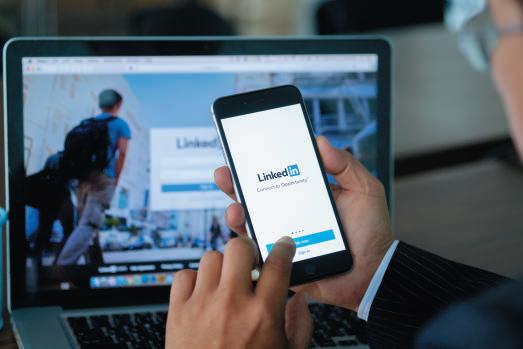
4 minute read
sales and marketing How I Learned to Use LinkedIn Effectively
You can learn valuable lessons about using LinkedIn by paying close attention to this user’s “experiments.”
MIRTMIRT/SHUTTERSTOCK.COM
By Bryce Sanders
Have you ever heard of “six degrees of separation”? This means that everyone in the world is connected to everyone else by six or fewer “who knows who” connections. This should be a bonanza for agents and advisors and should lead to business for them. I’m working on making it happen.
If you’ve been around for a while, you know that at first, the industry distanced itself from social media. Agents and advisors were forbidden to use it professionally, and insurance companies were worried they couldn’t archive communication or monitor messages before they were sent out. Then companies began to figure it out. They could outsource archiving and even monitoring. Agents and advisors could post from an archive of pre-approved articles and links. At that point, firms went in with both feet. Instead of forbidding the use of social media, they began to actively encourage it.
For example, in 2004, LinkedIn had a million users; in 2007, it crossed the 10 million mark.¹ It took financial services firms about a dozen years to become comfortable with it.
Agents and advisors are a clever bunch. By uploading address books, they built big networks of first-level connections. Firms enabled advisors to choose several articles along with the dates they would be automatically posted. Many took the automated route and wondered why business wasn’t rolling in.
My personal experiments last year
I was determined to learn how to utilize LinkedIn efficiently, so in 2017 and 2018 I launched and repeated my first strategy, based on the following steps:
Reach out to everyone. When I started, I probably had over 900 connections. I was determined to make contact with each one personally. My goal was to send a dozen messages per day. It took me about five months to achieve this goal. I used a prewritten block of text, which I customized. Since many people who connect immediately try to start selling their product or service, I led with a tame question: “How do you use LinkedIn?” I volunteered what I do. Result: In 2017 I had about 250 responses of various types. I received over 100 invitations to connect, but that might have been related to published articles or training seminars.
Send a personal message to everyone I know. In 2018 my network grew to about 1,300-plus first-level connections. One of the lessons I learned from my earlier project, which ended in June, was that some people thought my messages weren’t personal enough. In August, I started sending five personal messages each day, specifically to first-level connections I know personally. This takes longer, because each message is written from scratch. Result: This approach is getting a dialog started with a segment of my contacts. Since it’s done alphabetically, in early December I was getting to the “K’s.”
Marketing on my terms. Posting to the daily news feed makes sense, but you don’t know if your connections will see your post because there are so many sponsored posts. There are lots of “John Smith ‘liked’ the following post” messages. In my business, I want to cultivate local managers and people at money management firms. I’ve built two lists. About once a quarter, I take an article from the link I’ve posted and “share” it individually with each name on each list. Since these articles are sent one at a time, it usually takes me about a week to do, if I spend an hour a day on them. The covering note is personalized. Result: It’s hard to measure, but it keeps me topof-mind with users. I’ve actually gotten some business.
Steps for success
So far, we’ve looked at two extremes: the advisor who automates the procedure, expecting business to follow, and my “high-touch” strategy. What you do depends on what your firm allows you to do. Here are seven actions you can take. They may sound obvious, but lots of people aren’t doing them.
1. Post regularly. Ideally you choose the article or link that day. This makes it timely.
2. Pay attention to comments. If people “like” your post, thank them. If people “comment” on your post, comment on their comment. If you don’t know them, suggest connecting with them.
3. Read other people’s posts. Like or comment on these posts as appropriate.
4. Join groups. Members of your alumni association and local chamber should all have groups. If you worked in another industry before joining your current business, the company you previously worked for likely has an alumni group.
5. Read group posts. Like and comment on them.
6. Post to groups. The cool thing is that many people in the group aren’t your connections yet. They share an interest of affinity. If you comment, they might send an invitation to connect or they might comment back. Either way, you are getting a dialog going.
7. Remember that it’s personal. When you make a connection, you might have a dialog going back and forth. This shows that your connections have a degree of interest in you or are at least open to talking with you. You eventually want to turn this into a face-to-face meeting. One of the greatest things about LinkedIn is that it isn’t oversaturated yet. Once upon a time, cold calling was the preferred prospecting strategy. Then there was voicemail, caller ID and the Do Not Call list. Today, LinkedIn is like the American frontier in western movies — it’s still being settled. Many people are trying to figure out how to use it effectively, creating a possible opportunity for you.
References
1 Wikipedia. “LinkedIn.” https://en.wikipedia.org/wiki/LinkedIn#Founding_to_2010
Bryce Sanders is president of Perceptive Business Solutions Inc. He provides HNW client acquisition training for the financial services industry. His book, Captivating the Wealthy Investor, can be found on Amazon.







